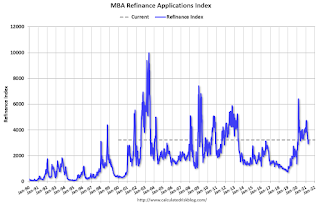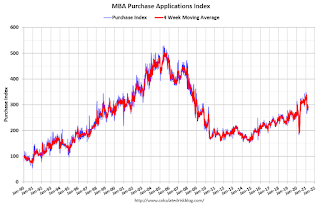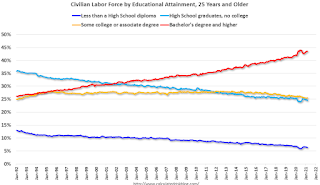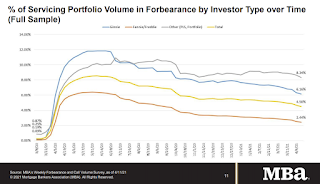by Calculated Risk on 4/21/2021 10:37:00 AM
Wednesday, April 21, 2021
AIA: "Demand for Architecture design services continues to rapidly escalate" in March
Note: This index is a leading indicator primarily for new Commercial Real Estate (CRE) investment.
From the AIA: Demand for design services continues to rapidly escalate
Strengthening to a score not seen since pre-Great Recession, the Architecture Billings Index (ABI) logged its second positive mark since the beginning of the pandemic, according to a new report today from The American Institute of Architects (AIA).
AIA’s ABI score for March rose to 55.6 compared to 53.3 in February (any score above 50 indicates an increase in billings). Scores for both new projects inquiries and new design contracts strengthened to 66.9 and 55.7 respectively. March also marked the first time in three years all building sectors and regions posted positive scores.
“As business activity at architecture firms moves sharply toward recovery, it is very encouraging to simultaneously see such positive indicators of future project work increasing in the pipeline,” said AIA Chief Economist, Kermit Baker, Hon. AIA, PhD. “The activity architecture firms are seeing is a positive bellwether not only for the construction outlook, but also for the larger economy.”
...
• Regional averages: Midwest (56.5); South (55.8); West (52.8); Northeast (50.8)
• Sector index breakdown: commercial/industrial (57.0); mixed practice (54.9); institutional (54.4); multi-family residential (52.6)
emphasis added
 Click on graph for larger image.
Click on graph for larger image.This graph shows the Architecture Billings Index since 1996. The index was at 55.6 in March, up from 53.3 in February. Anything above 50 indicates expansion in demand for architects' services.
Note: This includes commercial and industrial facilities like hotels and office buildings, multi-family residential, as well as schools, hospitals and other institutions.
This index had been below 50 for eleven consecutive months, but has been solidly positive for the last two months.
MBA: Mortgage Applications Increase in Latest Weekly Survey
by Calculated Risk on 4/21/2021 07:00:00 AM
From the MBA: Mortgage Applications Increase in Latest MBA Weekly Survey
Mortgage applications increased 8.6 percent from one week earlier, according to data from the Mortgage Bankers Association’s (MBA) Weekly Mortgage Applications Survey for the week ending April 16, 2021.
... The Refinance Index increased 10 percent from the previous week and was 23 percent lower than the same week one year ago. The seasonally adjusted Purchase Index increased 6 percent from one week earlier. The unadjusted Purchase Index increased 7 percent compared with the previous week and was 57 percent higher than the same week one year ago.
“Mortgage rates dropped to their lowest levels in around two months, prompting a small resurgence in refinance activity after six weeks of declines. Borrowers acted on the decrease in rates for most loan types, with both conventional and government refinance applications showing gains,” said Joel Kan, MBA’s Associate Vice President of Economic and Industry Forecasting. “The spring housing market also saw a boost from lower rates, with purchase applications – driven by a jump in conventional applications – increasing over 5 percent. MBA expects the purchase market to remain strong, with the recovering job market and supportive demographics fueling housing demand in the months ahead.”
Added Kan, “The average loan size for purchase applications increased after a few weeks of declines, as fewer homes available for sale make for a competitive buying market that is accelerating home-price growth.”
...
The average contract interest rate for 30-year fixed-rate mortgages with conforming loan balances ($548,250 or less) decreased to 3.20 percent from 3.27 percent, with points increasing to 0.36 from 0.33 (including the origination fee) for 80 percent loan-to-value ratio (LTV) loans.
emphasis added
 Click on graph for larger image.
Click on graph for larger image.The first graph shows the refinance index since 1990.
With low rates, the index remains elevated, but below recent levels since mortgage rates have moved up from the record lows.
The second graph shows the MBA mortgage purchase index
 According to the MBA, purchase activity is up 57% year-over-year unadjusted.
According to the MBA, purchase activity is up 57% year-over-year unadjusted.Note: Until the 2nd half of May, the MBA index will be up sharply year-over-year since purchase activity collapsed in late March 2020 in the early weeks of the pandemic.
Note: Red is a four-week average (blue is weekly).
Tuesday, April 20, 2021
April 20th COVID-19 Vaccinations, New Cases, Hospitalizations
by Calculated Risk on 4/20/2021 07:38:00 PM
Note: I'm looking forward to not posting this daily! I've been posting this data daily for over a year, and I'll stop once all three of these criteria are met:
1) 70% of the population over 18 has had at least one dose of vaccine,
2) new cases are under 5,000 per day, and
3) hospitalizations are below 3,000.
According to the CDC, 213.4 million doses have been administered. 33.3% of the population over 18 is fully vaccinated, and 51.1% of the population over 18 has had at least one dose (131.9 million people over 18 have had at least one dose).
And check out COVID Act Now to see how each state is doing.
 Click on graph for larger image.
Click on graph for larger image.This graph shows the daily (columns) 7 day average (line) of positive tests reported.
Note: The ups and downs during the Winter surge were related to reporting delays due to the Thanksgiving and Christmas holidays.
This data is from the CDC.
The second graph shows the number of people hospitalized.
 This data is also from the CDC.
This data is also from the CDC.The CDC cautions that due to reporting delays, the area in grey will probably increase.
Indiana Real Estate in March: Sales Down 3% YoY, Inventory Down 58% YoY
by Calculated Risk on 4/20/2021 06:48:00 PM
Note: I'm tracking data for many local markets around the U.S. I think it is especially important to watch inventory this year.
For for the entire state Indiana:
Closed sales in March 2021 were 7,181, down 3.0% from 7,401 in March 2020.
Active Listings in March 2021 were 5,898, down 57.6% from 13,916 in March 2020.
Months of Supply was 0.7 Months in March 2021, compared to 1.8 Months in March 2020.
Alabama Real Estate in March: Sales Up 23% YoY, Inventory Down 46% YoY
by Calculated Risk on 4/20/2021 05:57:00 PM
Note: I'm tracking data for many local markets around the U.S. I think it is especially important to watch inventory this year.
For the entire state of Alabama:
Closed sales in March 2021 were 7,024, up 23.4% from 5,690 in March 2020.
Active Listings in March 2021 were 9,721, down 46.4% from 18,122 in March 2020.
Months of Supply was 1.4 Months in March 2021, compared to 3.2 Months in March 2020.
The Upward Slope of Real House Prices
by Calculated Risk on 4/20/2021 12:52:00 PM
Many years ago, I wrote: The upward slope of Real House Prices. I argued that real house prices (adjusted for inflation) had typically increased about 1.0% to 1.5% per year (much higher than Professor Shiller's estimate of 0.2%).
In 2012, housing economist Tom Lawler dug through some data and calculated that real prices increased 0.83% per year (See: Lawler: On the upward trend in Real House Prices)
 Click on graph for larger image.
Click on graph for larger image.This graph shows there have been four surges in real prices since the early '70s. One in the late '70s, one in the late '80s, the housing bubble, and the current surge in prices.
It is important to note that nationally nominal house prices did not decline following the surges in the '70s and '80s. However, there were regional declines.
Since homeowners are concerned about nominal prices (not real prices), I wasn't concerned in December 2018, when Professor Shiller wrote in the NY Times: The Housing Boom Is Already Gigantic. How Long Can It Last?
During the housing bubble, the difference between a slight upward slope in real prices (0.2% per year according to Shiller's index) and a slightly larger increase in real prices using other indexes (probably between 1% and 1.5% per year) didn't make any difference; there was obviously a huge bubble in house prices. But when comparing price "booms" over time, there is a huge difference.
If we use 1.5% per year for real price increases, the current "boom" in prices would be the fourth largest since the 1970s (and only about half the size of the late '70s and late '80s price boom), and if we use a 1.0% real increase, the current "boom" is on the same order as the late '70s and '80s price booms.
No big deal, and definitely not a "gigantic" boom in house prices.
Now, I'd argue house prices are too high based on historical real prices. Prices are also too high based on price-to-rent measures, and price-to-income.
I wouldn't call this a "bubble" because of the lack of both speculation and loose lending (see: Is there a New Housing Bubble?). But I am becoming concerned about fundamentals:
Maybe prices are too high based on fundamentals (due to extremely low supply and record low mortgage rates), but there is very little evidence of speculation (not like the loose lending of the housing bubble).
...
The lack of wild speculation doesn't mean house prices can't decline, but it means that we won't see cascading declines in prices like what happened when the housing bubble burst.
...
We might see some price declines, especially in some 2nd home areas that saw a surge in demand at the onset of the pandemic, but the recent buyers are all well qualified, and some price declines will not lead to forced selling. So there is no threat to the financial system with widespread defaults.
CoreLogic: Mortgage Application Fraud Risk Index increased in Q1
by Calculated Risk on 4/20/2021 10:38:00 AM
A few excerpts from CoreLogic: Q1 2021 Mortgage Fraud Brief
The CoreLogic® National Mortgage Application Fraud Risk Index (Index) increased by 11.9% for the first quarter of 2021—from 110 to 122. The year-over-year trend is up 7.7% from Q1 2020 (at 113).CR Note: This is still low, but something to watch.
Last quarter we noted an uptick in income reasonability alerts for both purchases and refinances and that trend continued in Q1. Valuation alerts increased for all transactions, due to rapid home price increases as demand exceeds supply. We observed a slight increase in occupancy alerts for refinances, along with a decrease in flipping alerts for purchases.
We expect fraud risk to continue to rise in 2021, fueled by an insufficient supply of affordable housing and rising interest rates that will change the purchase/refinance mix. New guidelines on GSE financing for investment and second homes, including a 7% cap and stricter underwriting guidelines have the potential to heighten occupancy misrep motivations.
emphasis added
Trends in Educational Attainment in the U.S. Labor Force
by Calculated Risk on 4/20/2021 08:47:00 AM
The first graph shows the unemployment rate by four levels of education (all groups are 25 years and older) through March 2021. Note: This is an update to a post from a few years ago.
Unfortunately this data only goes back to 1992 and includes only three recessions (the stock / tech bust in 2001, and the housing bust/financial crisis, and the 2020 pandemic). Clearly education matters with regards to the unemployment rate, with the lowest rate for college graduates at 3.7% in March, and highest for those without a high school degree at 8.2% in March.
All four groups were generally trending down prior to the pandemic. And all are trending down now.

Note: This says nothing about the quality of jobs - as an example, a college graduate working at minimum wage would be considered "employed".
This brings up an interesting question: What is the composition of the labor force by educational attainment, and how has that been changing over time?
Here is some data on the U.S. labor force by educational attainment since 1992.

This is the only category trending up. "Some college" has been steady (and trending down lately), and both "high school" and "less than high school" have been trending down.
Based on current trends, probably more than half the labor force will have at least a bachelor's degree by the end of this decade (2020s).
Some thoughts: Since workers with bachelor's degrees typically have a lower unemployment rate, rising educational attainment is probably a factor in pushing down the overall unemployment rate over time.
Also, I'd guess more education would mean less labor turnover, and that education is a factor in lower weekly claims (prior to the pandemic).
A more educated labor force is a positive for the future.
Monday, April 19, 2021
April 19th COVID-19 Vaccinations, New Cases, Hospitalizations; Spring Wave May Have Peaked
by Calculated Risk on 4/19/2021 05:15:00 PM
Note: I'm looking forward to not posting this daily! I've been posting this data daily for over a year, and I'll stop once all three of these criteria are met:
1) 70% of the population over 18 has had at least one dose of vaccine,
2) new cases are under 5,000 per day, and
3) hospitalizations are below 3,000.
According to the CDC, 211.6 million doses have been administered. 33.0% of the population over 18 is fully vaccinated, and 50.7% of the population over 18 has had at least one dose (131.0 million people over 18 have had at least one dose).
And check out COVID Act Now to see how each state is doing.
 Click on graph for larger image.
Click on graph for larger image.This graph shows the daily (columns) 7 day average (line) of positive tests reported.
Note: The ups and downs during the Winter surge were related to reporting delays due to the Thanksgiving and Christmas holidays.
This data is from the CDC.
The second graph shows the number of people hospitalized.
 This data is also from the CDC.
This data is also from the CDC.The CDC cautions that due to reporting delays, the area in grey will probably increase.
MBA Survey: "Share of Mortgage Loans in Forbearance Decreases to 4.50%"
by Calculated Risk on 4/19/2021 04:00:00 PM
Note: This is as of April 11th.
From the MBA: Share of Mortgage Loans in Forbearance Decreases to 4.50%
The Mortgage Bankers Association’s (MBA) latest Forbearance and Call Volume Survey revealed that the total number of loans now in forbearance decreased by 16 basis points from 4.66% of servicers’ portfolio volume in the prior week to 4.50% as of April 11, 2021. According to MBA’s estimate, 2.3 million homeowners are in forbearance plans.
...
“The share of loans in forbearance decreased for the seventh straight week and has now dropped 40 basis points in the last two weeks. The forbearance share decreased for all three investor categories, with the rate for portfolio and PLS loans decreasing by 31 basis points this past week – the largest drop across investor categories,” said Mike Fratantoni, MBA’s Senior Vice President and Chief Economist. “Forbearance exits increased for portfolio and PLS loans but decreased for GSE and Ginnie Mae loans. More than 36 percent of borrowers in forbearance extensions have now exceeded the 12-month mark.”
Fratantoni added, “Economic data on home construction and consumer spending in March show a strong housing market and a quickened pace of economic activity. Combined with the homeowner assistance and stimulus payments that many households are receiving, we expect that the forbearance numbers will continue to decline in the months ahead as more individuals regain employment. Homeowners who are still facing hardships and need to extend their forbearance term should contact their servicers.”
emphasis added
 Click on graph for larger image.
Click on graph for larger image.This graph shows the percent of portfolio in forbearance by investor type over time. Most of the increase was in late March and early April, and has trended down since then.
The MBA notes: "Total weekly forbearance requests as a percent of servicing portfolio volume (#) remained flat relative to the prior week at 0.05%."


